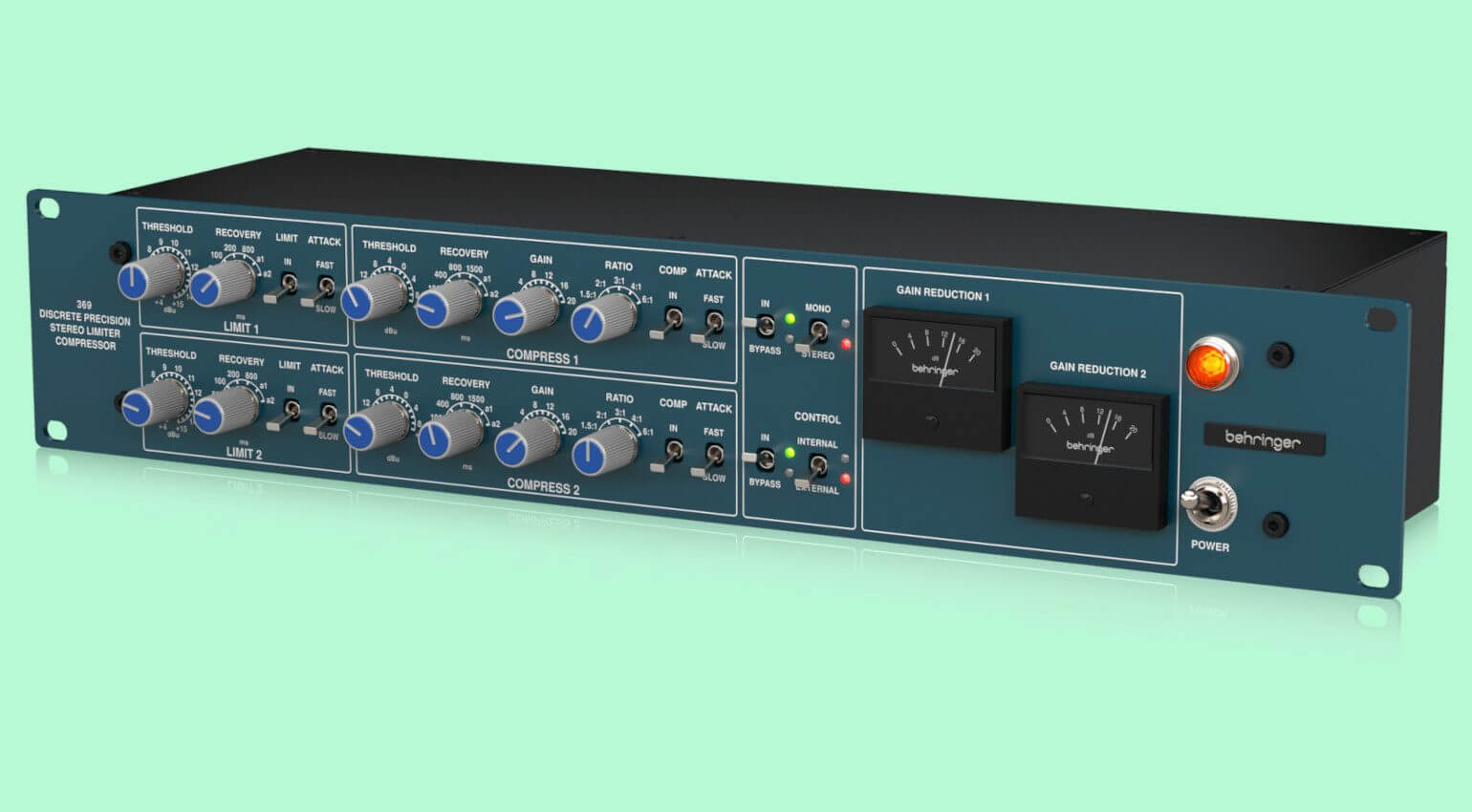Behringer 369 Review: Affordable Analog Warmth and Vintage Compression for Every Studio

The Behringer 369 has quickly garnered attention as a versatile, vintage-inspired compressor and limiter that offers a compelling alternative for audio engineers seeking that sought-after analog warmth. Designed with a nod to the Neve 33609, a legendary compressor revered for its unique tonal qualities and robust performance, the Behringer 369 is positioned as a more affordable entryway into the world of classic compression.
Design and Build Quality
The Behringer 369 boasts a 2U rackmount chassis, built with durability in mind to withstand the rigors of both studio environments and on-the-road usage. Its robust metal construction suggests longevity, ensuring the unit can handle the demands of frequent use. The physical layout of the Behringer 369 is straightforward, with controls and meters prominently displayed on the front panel, making it relatively intuitive to operate. While the design maintains a vintage aesthetic reminiscent of its inspiration, it combines this classic appeal with modern conveniences that are welcomed in today’s studios.
The front panel features gain reduction meters, a hallmark of vintage compressors, which allow users to visually monitor the amount of compression being applied. The switches and knobs are designed to replicate the tactile experience of older, analog compressors, which is an essential feature for users who appreciate the tangible aspect of analog gear. However, some users have noted that the control knobs could feel a bit stiff, affecting precision when making minor adjustments. Despite these minor drawbacks, the build quality overall feels solid and reliable for most users.
Sound Quality and Tone Characteristics
At the heart of the Behringer 369 is its ability to emulate the warm, rich tonal qualities that made the Neve 33609 famous. The Behringer 369 provides a discrete, transformer-balanced signal path, which plays a major role in delivering that analog sound. The unit’s custom input and output transformers are designed to impart a subtle harmonic coloration that adds depth and fullness to audio signals.
When it comes to compression, the Behringer 369 stands out for its ability to handle a wide variety of sources with finesse. On drums, it can add punch and clarity without squashing the transients, preserving the natural dynamics of the performance while tightening up the sound. When applied to vocals, the 369 brings a level of smoothness and polish that enhances the presence of the voice in a mix. Its subtle saturation, brought on by the analog circuitry, adds warmth to instruments and vocals alike, making them sound fuller and more engaging.
For users seeking a transparent compressor, the Behringer 369 provides a versatile experience with different compression ratios and attack and release settings. It offers options for both gentle, transparent compression that subtly shapes the sound and more aggressive settings that bring a distinct tonal character. This versatility makes it suitable for both subtle bus compression on a mix and more pronounced compression on individual tracks like bass or lead vocals.
Compressor and Limiter Sections
The Behringer 369 features two primary sections: the compressor and the limiter. Each serves a specific function, allowing users to handle dynamic range control with precision. The compressor section is capable of operating in a range of ratios from 1.5:1 to 6:1, giving users flexibility in managing dynamics. Lower ratios are great for subtle smoothing of dynamics, which is particularly useful on the mix bus, while higher ratios are effective for containing peaks on individual instruments.
One of the standout aspects of the compressor section is its switchable attack times, which let users tailor the compressor’s response to different types of sources. The slower attack settings allow transients to pass through, making it ideal for preserving the punch of percussive elements. Faster attack settings, on the other hand, are useful for controlling more aggressive peaks, such as those found in brass or electric guitar tracks.
The limiter section offers an additional layer of control for managing peaks and ensuring that the overall signal level stays within the desired range. This can be particularly helpful when dealing with loud vocalists or instruments that tend to generate sudden volume spikes. While the limiter does provide a level of control, it may not be as transparent or effective as some users expect. The limiter on the Behringer 369 is generally best used for subtle peak management rather than as a hard ceiling.
Usability in the Studio
For audio professionals, usability is key, and the Behringer 369 generally delivers a user-friendly experience. With its straightforward layout and intuitive controls, users familiar with analog gear will find it easy to dial in settings quickly. The visual feedback from the vintage-style gain reduction meters is a nice touch, providing instant insight into how much compression is being applied. This feature is especially helpful for users who prefer to rely on visual cues in addition to their ears when setting compression parameters.
For engineers new to outboard compressors, the Behringer 369 is accessible, with a learning curve that is manageable. The control layout is intuitive enough to encourage experimentation, and users can quickly develop an understanding of how different settings impact the sound. It’s particularly suitable for users who want to get hands-on with compression but may not have the budget for a high-end piece of equipment.
Applications and Versatility
One of the strongest aspects of the Behringer 369 is its versatility across various audio applications. For recording engineers, it can be used to bring character and warmth to individual instrument tracks, especially when tracking bass guitars, kick drums, and snares. The ability to adjust attack and release times ensures that users can tailor the compression to enhance the natural qualities of each source, whether it's adding weight to a snare drum or enhancing the sustain of a bass guitar.
When it comes to mixing, the Behringer 369 can be deployed on the mix bus, bringing cohesiveness to a mix without overwhelming the original dynamics. This is particularly valuable for those looking to achieve a polished, professional sound that rivals higher-end studio gear. It can also be used on drum buses to add a sense of glue, making individual drum elements feel like a cohesive unit.
For mastering engineers, the Behringer 369 provides an affordable alternative for adding final touches to a mix, especially in genres where a bit of analog warmth is desirable. While it may lack some of the finer controls of more expensive mastering compressors, it still offers enough functionality to add value in a mastering chain.
Value Proposition
In terms of value for money, the Behringer 369 is an impressive option for engineers who want the sound of a high-end analog compressor without the premium price tag. While high-end units like the Neve 33609 can cost thousands of dollars, the Behringer 369 is priced at a fraction of that cost, making it accessible to smaller studios and independent producers. This is a game-changer for those who seek quality sound on a budget, as it allows for a level of tonal richness that is usually associated with more expensive gear.
The Behringer 369 is well-suited for a range of users, from hobbyists looking to add a professional touch to their mixes to more seasoned engineers who want an affordable alternative to their go-to compressors. While it may not match the exact performance of its high-end counterparts, it offers significant value given its price point.
Potential Drawbacks
No piece of gear is without its drawbacks, and the Behringer 369 is no exception. While the build quality is generally robust, there have been reports of quality control inconsistencies, with some units exhibiting cosmetic defects upon arrival. This suggests that the manufacturing standards may vary, which is something buyers should keep in mind.
The control knobs, though functional, could benefit from a bit more precision. Some users have found them a bit tight or imprecise, which can make it challenging to make fine adjustments. For those who are used to the precise controls of high-end compressors, this may be a noticeable difference.
Another limitation is the performance of the limiter section. While the compressor section of the Behringer 369 performs admirably, the limiter may not be as effective, particularly when handling extreme peaks. This doesn’t detract from the overall usability of the unit, but it’s worth noting that the limiter may not be suitable for all applications, especially if hard limiting is required.
Conclusion
In summary, the Behringer 369 offers a unique combination of vintage-inspired sound, affordability, and user-friendly operation. It successfully captures the essence of classic analog compression, making it a valuable tool for adding warmth and character to audio projects. With its wide range of applications, from individual track processing to mix bus compression, the Behringer 369 serves as a versatile and accessible solution for studios of all sizes.
The Behringer 369 shines in applications where warmth and musicality are desired, making it an excellent choice for engineers who prioritize tonal quality and analog warmth. While it may not fully replicate the iconic sound of the Neve 33609, it provides a satisfying alternative at a budget-friendly price point. For users looking to add a touch of vintage character to their projects without a substantial financial investment, the Behringer 369 is a compelling choice that delivers in most areas that matter.
Its minor limitations, such as control knob precision and the somewhat limited limiter, are overshadowed by its strengths, particularly when considering the price. Ultimately, the Behringer 369 is a solid entry-level compressor and limiter that allows engineers to experience analog-style processing and expand their creative possibilities in music production. Whether you’re an aspiring producer or a seasoned engineer looking for a reliable piece of gear, the Behringer 369 is worth considering as a valuable addition to any studio setup.










Leave a comment
All comments are moderated before being published.